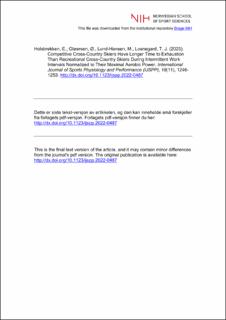| dc.description.abstract | Objective Associations between occupational physical activity (OPA) and mortality risks are inconclusive. We aimed to examine associations between (1) OPA separately and (2) jointly with leisure time physical activity (LTPA), and risk of all-cause, cardiovascular disease (CVD) and cancer mortality, over four decades with updated exposure and covariates every 6–8 years.
Methods Adults aged 20–65 years from the Tromsø Study surveys Tromsø3-Tromsø7 (1986–2016) were included. We categorised OPA as low (sedentary), moderate (walking work), high (walking+lifting work) or very high (heavy manual labour) and LTPA as inactive, moderate and vigorous. We used Cox/Fine and Gray regressions to examine associations, adjusted for age, body mass index, smoking, education, diet, alcohol and LTPA (aim 1 only).
Results Of 29 605 participants with 44 140 total observations, 4131 (14.0%) died, 1057 (25.6%) from CVD and 1660 (40.4%) from cancer, during follow-up (median: 29.1 years, 25th–75th: 16.5.1–35.3). In men, compared with low OPA, high OPA was associated with lower all-cause (HR 0.83, 95% CI 0.74 to 0.92) and CVD (subdistributed HR (SHR) 0.68, 95% CI 0.54 to 0.84) but not cancer mortality (SHR 0.99, 95% CI 0.84 to 1.19), while no association was observed for moderate or very high OPA. In joint analyses using inactive LTPA and low OPA as reference, vigorous LTPA was associated with lower all-cause mortality combined with low (HR 0.75, 95% CI 0.64 to 0.89), high (HR 0.67, 95% CI 0.54 to 0.82) and very high OPA (HR 0.74, 95% CI 0.58 to 0.94), but not with moderate OPA. In women, there were no associations between OPA, or combined OPA and LTPA, with mortality.
Conclusion High OPA, but not moderate and very high OPA, was associated with lower all-cause and CVD mortality risk in men but not in women. Vigorous LTPA was associated with lower mortality risk in men with low, high and very high OPA, but not moderate OPA. | en_US |

